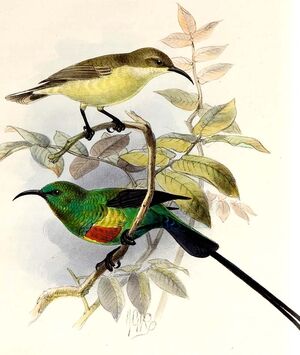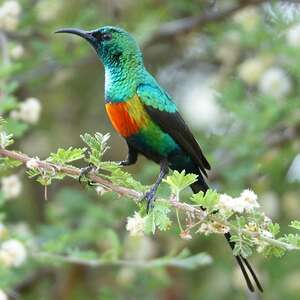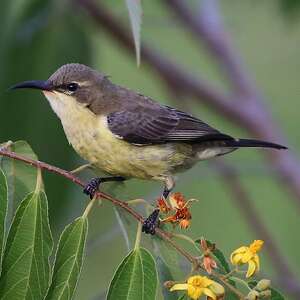Beautiful Sunbird
Cinnyris pulchellus - Souimanga à longue queue
Identification
The Beautiful Sunbird is a medium-sized, slender Nectariniids with a curved long bill. Adding the size of the long tail feathers of the male reproductive, we are rather on a larger sunbird. Indeed, the projections can reach up to 6 cm. The dimorphism is once again very much marked as is the case in almost all of this family. In nuptial plumage, the male has a head, upper parts, upper wings and a iridescent metallic green rump. Each specimen can appear lighter or darker depending on the iridescence of the feathers, which is due to the fine air bubbles trapped in the keratin of the feathers. The size of these bubbles modifies the color of the feathers according to the light. The feathers of the chin, throat and upper chest form small scales and are metallic green with more or less, or even strongly, golden reflections depending on the regions. In the southeastern part of its range, the throat may appear black. Sometimes a thin horizontal blue-turquoise or dark blue line forming a collar separates the throat from the chest. This detail is again variable depending on the region. A central and vertical scarlet red spot in the middle of the chest stands out strongly against the two yellow sides. The abdomen is shiny metallic green in most of its range but is black in the southeast. The flanks and under-tails are metallic blue. The tail is black-blue to dark brown, narrow metallic green fringes are visible on the inner rectrices, they are wider on the two central rectrices. The iris is dark brown, the bill and legs are black. The male's eclipse plumage is similar to the female's, it is gray-brown on the top and dull yellow on the bottom, while the feathers of the wings and tail are black.Central tail-covert feathers are often retained in this non-breeding plumage. The chin, throat, coverts, some of the rump feathers and upper tail-coverts are metallic green. In some males the chin and throat feathers are dropped during this time, revealing a pale patch on the throat. The female plumage is not iridescent. The upper crown to the rump is clear brown-gray tinged with dull yellowish. The remiges and greater coverts are dark brown with pale yellowish-olive edges. The tail is dark brown slightly lustrous with greenish-bronze or bluish. The tail feathers are narrowly edged with white, edges that become wider on the two outer feathers. The lores are dark brown and a white or pale yellow eyebrow extending behind the eye contrasts with the upper parts. The underparts from the chin to the undertail-coverts are yellow with variable and indistinct blackish-brown mottling on the breast and flanks. The juvenile male resembles the female with a wide black vertical band visible from the chin to the top of the chest. Two large yellowish-white mustaches descend from both sides of the throat to the shoulders.
Subspecific information monotypic species
Foreign names
- Souimanga à longue queue,
- Suimanga colilargo sudanés,
- nectarínia-linda,
- Elfennektarvogel,
- pompás nektármadár,
- Feeënhoningzuiger,
- Nettarinia magnifica,
- smyckesolfågel,
- Fagersolfugl,
- nektárovka nádherná,
- strdimil nádherný,
- Langhalet Pragtsolfugl,
- kaunomedestäjä,
- suimanga llampant,
- nektarnik piękny,
- Нектарница-эльф,
- ウツクシオナガタイヨウチョウ,
- 丽色花蜜鸟,
- smyckesolfågel,
- 麗色花蜜鳥,
Voice song and call
The song of the Beautiful Sunbird consists of a twittering of rising and falling high notes, including ti-tsu-tswee and similar variations, lasting for nearly a minute, sometimes including series of rising 3 to 4 notes tsi. This may be interspersed with many rapid repetitions of che (5 to 8 per second), which can sometimes be repeated by themselves for around 1 minute. Calls consist of repeated chip-chip.
Habitat
The Beautiful Sunbird is a species that inhabit dry and arid environments, but is usually found near water bodies and in open areas. It lives and reproduces in dry thorn savannahs, on the edges of semi-permanent rivers and adjacent marshes, in small gardens, lush undergrowth of mangroves and along the coast. Its altitudinal presence does not exceed 1,300 meters in Kenya and Uganda, and can reach 1,530 meters in Ethiopia.
Behaviour character trait
The Beautiful Sunbird is a resident throughout its range, except in the extreme north. Some movements are apparently related to the flowering of Loranthaceae, such as in Chad during the flowering of Tapinanthus globiferus, as well as during the breeding season. In the center of Kenya, it moves to higher altitudes during severe drought periods. Very territorial, it is also a very active bird.
Flight
Dietfeeding habits
The Beautiful Sunbird feeds on nectar from small flowers, as well as insects and small spiders that it gathers on windows or rooftops.
It feeds alone, high up or less than one metre from the ground, sometimes in small groups. The best-known flowers it looks for are from the Fabaceae family such as acacia, albizia, tamarindus; Nyctaginaceae such as bougainvillea; Malvaceae such as hibiscus; Verbenaceae such as lantana; and Bignoniaceae such as jacaranda. It also visits the flowers of small gardens.Reproduction nesting
The Beautiful Sunbird breeds during the rain season. Southwestern African populations move north to breed from February to April, returning south from September to October. In the northern part of its range, some populations present during the dry season migrate south at the beginning of the rains to breed there. Nestings are recorded from June to October in Mauritania and Senegal, from June to March in Gambia, in July in Mali, in June in Burkina Faso, in April and from August to September in Ghana, from June to July in Niger, in February and from June to October in Nigeria, from July to August in Chad, in July in Eritrea, from April to October in Ethiopia, in March and from June to October in Sudan, from February to March, from May to June and from August to October in Uganda, and in July in northern Kenya.
Although this species is territorial, polygamy is suspected as the male can court two females simultaneously. He displays himself in front of the female by spreading his wings and tail. To intimidate other contenders, males show each other from the tops of the trees, displaying their underparts colors while standing in a vertical position, flapping their wings and shaking their tail in a fan. The purse-shaped nest, 12 cm high and 5 cm wide, has a central entryway without a porch. It is suspended in a tree from one meter to five meters above the ground. The selected species are usually Acacia sp, Bauhinia reticulata, Citrus sp., Tamarindus indica and Ziziphus mauritiana. It is made of various fibers, bark, twigs, herbs, leaves, spider webs, plant down, stems, feathers, lichens, and snake skin.Its plumage is doubled by either feathers or plant down, sometimes decorated with lichen. The female lays one or two lightly shining eggs, ranging from green to blue-gray, brown or gray-white with streaks and dark gray, brown or ash-colored spots, sometimes in dark sepia. The incubation of the eggs and the hatching of the chicks is taken care of solely by the female. The incubation period and the time for feeding the young has not been documented. It is conceivable that upon hatching, both parents participate in the feeding, as is the case with Beautiful Sunbirds.Geographic range
The distribution range of the Beautiful Sunbird stretches horizontally across the northern part of Sub-Saharan Africa. However, there are few observations in Sudan and South Sudan and none in the Central African Republic, which applies to all the bird species of these countries. There is therefore no proof that the species is not present. Two subspecies share this distribution. South-east Kenya, west, central and south Tanzania is inhabited by the subspecies Cinnyris pulchellus melanogastrus. The nominate subspecies Cinnyris pulchellus pulchellus is present from south-west Mauritania to Sierra Leone, Burkina Faso, Mali, Ghana, Benin, Nigeria, Cameroon, Chad, Eritrea, Ethiopia and north-west Kenya.
Threats - protection
IUCN conservation status
concern
in the Wild
threatened
evaluated
The Beautiful Sunbird is not threatened globally. It is common, even locally abundant in most of its range, particularly in Eritrea, Ethiopia, north-western Kenya, Mauritania, Senegal and Sudan. However, it is heavily affected by habitat degradation. The average density in the Watucal Forest Reserve in northern Nigeria, for example, decreased by approximately 96% in the last decade of the last century. Fortunately, the Beautiful Sunbird is present in many protected areas. These include Comoé National Park in Ivory Coast, Bui National Park in Ghana, Waza National Park in Cameroon, Awash National Park in Ethiopia, Amboseli National Park in Kenya, Lake Manyara, Serengeti, Tarangire and Arusha National Parks in Tanzania and Murchison Falls National Park in Uganda.
Sources of information
- IOC World Bird List (v15.1), Gill, F and D Donsker (Eds). 2025-12-07.
- Birds of the World, The Cornell Lab of Ornithology
- Birds of East Africa: Kenya, Tanzania, Uganda, Rwanda, Burundi, Terry Stevenson, John Fanshawe
- Birds of the Horn of Africa, Nigel Redman
- Guide des oiseaux de l'Afrique de l'Ouest, Nik Borrow
- eBird, Cornell Lab of Ornithology et National Audubon Society
Other sources of interest
 Specification sheet created on
16/07/2023 by Nathalie Santa Maria
Specification sheet created on
16/07/2023 by Nathalie Santa MariaTranslation by AI Oiseaux.net
© 1996-2025 Oiseaux.net
- Accipitriformes
- Aegotheliformes
- Anseriformes
- Apodiformes
- Apterygiformes
- Bucerotiformes
- Caprimulgiformes
- Cariamiformes
- Casuariiformes
- Charadriiformes
- Ciconiiformes
- Coliiformes
- Columbiformes
- Coraciiformes
- Cuculiformes
- Eurypygiformes
- Falconiformes
- Galliformes
- Gaviiformes
- Gruiformes
- Leptosomiformes
- Mesitornithiformes
- Musophagiformes
- Nyctibiiformes
- Opisthocomiformes
- Otidiformes
- Passeriformes
- Pelecaniformes
- Phaethontiformes
- Phoenicopteriformes
- Piciformes
- Podargiformes
- Podicipediformes
- Procellariiformes
- Psittaciformes
- Pterocliformes
- Rheiformes
- Sphenisciformes
- Steatornithiformes
- Strigiformes
- Struthioniformes
- Suliformes
- Tinamiformes
- Trogoniformes

































